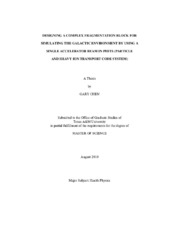| dc.contributor.advisor | Guetersloh, Stephen | |
| dc.creator | Chen, Gary | |
| dc.date.accessioned | 2011-10-21T22:02:53Z | |
| dc.date.accessioned | 2011-10-22T07:09:49Z | |
| dc.date.available | 2011-10-21T22:02:53Z | |
| dc.date.available | 2011-10-22T07:09:49Z | |
| dc.date.created | 2010-08 | |
| dc.date.issued | 2011-10-21 | |
| dc.date.submitted | August 2010 | |
| dc.identifier.uri | https://hdl.handle.net/1969.1/ETD-TAMU-2010-08-8281 | |
| dc.description.abstract | Radiation risks to humans in space will be better understood if ground-based mixed field irradiations are developed and used to measure the overall effectiveness of proposed space radiation shielding. The space environment is composed of wide range of particles containing various energies. Existing measurements illustrate the properties of galactic cosmic rays (GCR) in particle fluence and species. However, it is nearly impossible to simulate a radiation environment corresponding to both properties at once. Since the final objective of this thesis research is to understand radiation risks, and radiation risks are more directly related to the energy deposited in the human tissue than to fluence and charge, the more likely goal would be reproducing the linear energy transfer (LET) spectrum found in the GCR.
The purpose of this thesis research is to use a Monte Carlo transport code to study the fragmentation of a combined iron and proton beam source using a multi-depth moderator block to reproduce the LET component of the GCR. To study mixed-field radiation exposures, the Monte Carlo transport code - Particle and Heavy Ion Transport code System (PHITS) will be used.
Calculations showed it is necessary to design a moderator block that contains two different thicknesses - one with a length less than 23 cm and one with a length greater than 23 cm. The thinner moderator will allow high-Z particles to pass through and produce heavy-ion fragments that contribute mostly in the high-LET range. The thicker moderator will stop most of fragments and only allow lighter ions to penetrate and contribute to the mid-range and low-LET portion of the GCR spectrum. Since iron beams along will not produce enough low-LET particles, proton beams were employed to increase the abundance of the low-LET portion of the GCR spectrum.
After series of studies, it was concluded that a 17 cm and 49 cm thickness will be most effective. The initial conclusion of this project was that it is possible to produce the GCR environment using a multi-depth moderator block and a combined iron and proton beam. | en |
| dc.format.mimetype | application/pdf | |
| dc.language.iso | en_US | |
| dc.subject | simulating the space radiation environment | en |
| dc.title | Designing a Complex Fragmentation Block for Simulating the Galactic Environment by Using a Single Accelerator Beam in PHITS (Practicle and Heavy Ion Transport Code System) | en |
| dc.type | Thesis | en |
| thesis.degree.department | Nuclear Engineering | en |
| thesis.degree.discipline | Health Physics | en |
| thesis.degree.grantor | Texas A&M University | en |
| thesis.degree.name | Master of Science | en |
| thesis.degree.level | Masters | en |
| dc.contributor.committeeMember | Poston, John | |
| dc.contributor.committeeMember | Ford, John | |
| dc.contributor.committeeMember | Su, Chin | |
| dc.type.genre | thesis | en |
| dc.type.material | text | en |


